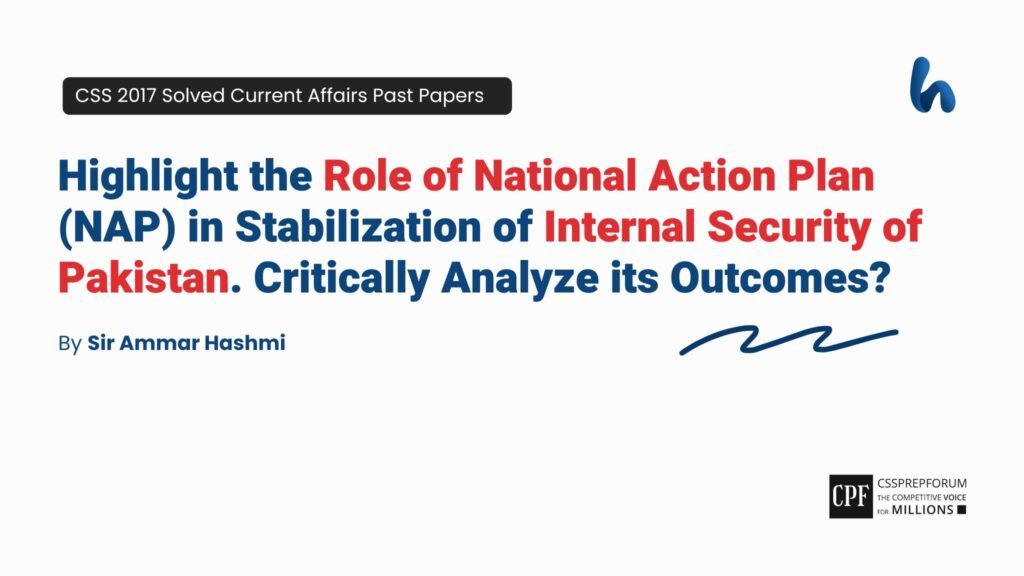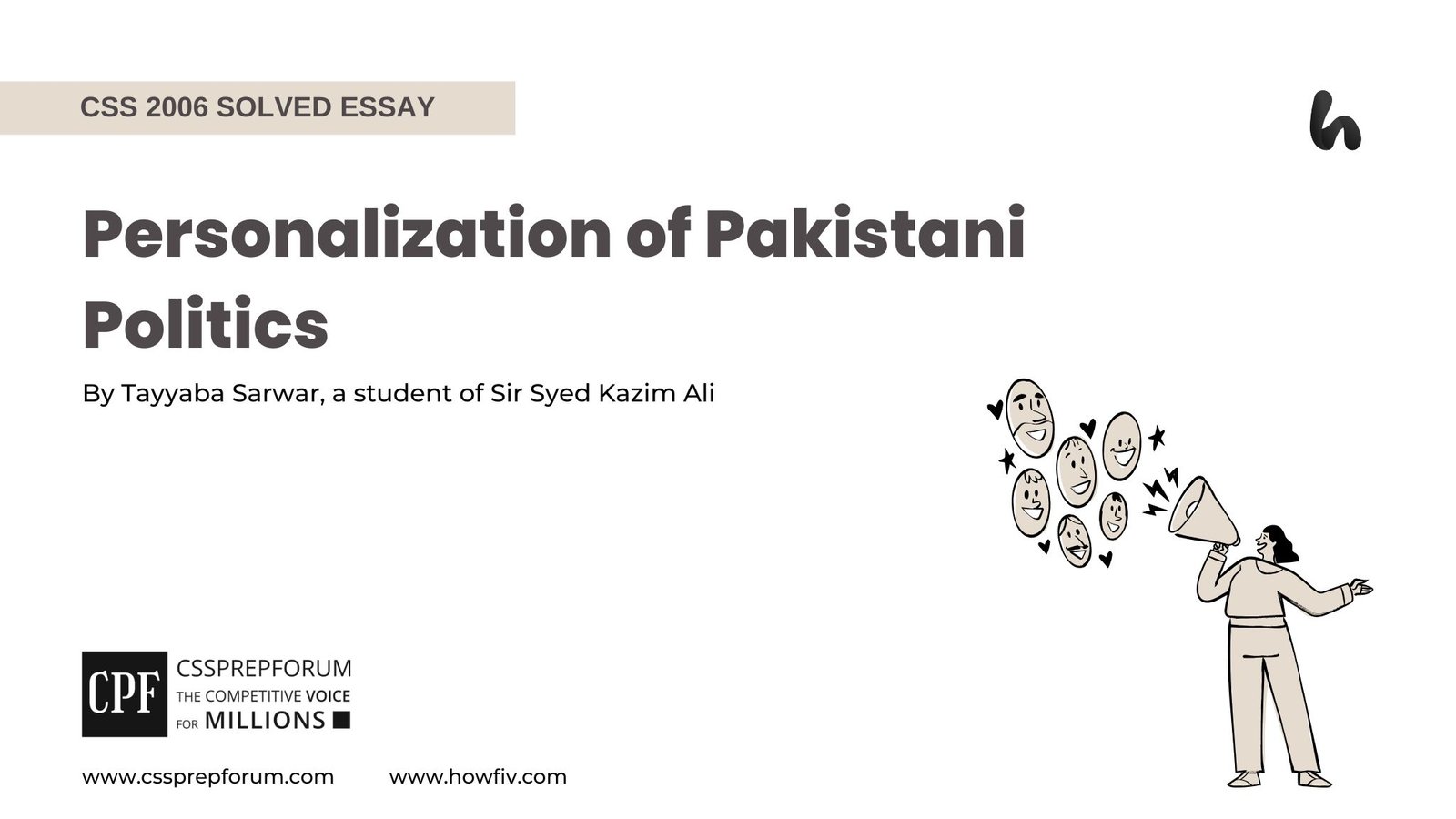CSS 2017 Solved Current Affairs Past Papers | NAP and the Internal Security of Pakistan
The following question of CSS Current Affairs 2017 is solved by Sir Ammar Hashmi, the best Current Affairs Coach, on the guided pattern of Sir Syed Kazim Ali, which he taught to his students, scoring the highest marks in compulsory subjects for years. This solved past paper question is uploaded to help aspirants understand how to crack a topic or question, how to write relevantly, what coherence is, and how to include and connect ideas, opinions, and suggestions to score the maximum.

Question breakdown
This question requires a focus on the National Action Plan’s role in enhancing Pakistan’s internal security. It also demands the deep understanding of the plan’s initiatives and their contribution to stabilization efforts. A critical analysis of the outcomes is essential, examining both the successes and the areas where the plan may have fallen short.
Outline
1-Introduction
2-Pakistan’s internal stability and the National Action Plan 2015
3-A critical review of NAP
- ✓ Significant Reduction in Terrorism Incidents
- ✓ Enhanced Law Enforcement Capabilities
- ✓ Crackdown on Terror Financing
- ✓ Regulation of Madrasas and Countering Extremist Narratives
- ✓ Rehabilitation and Mainstreaming of Former Militants
4-Critical Analysis
5-Conclusion

Answer to the question
Introduction
Terrorist organizations targeted civilians, military personnel, and critical infrastructure during the previous decade in Pakistan. Fundamentalists and extremists have exploited religious divisions to promote their agendas, which led to deadly attacks on religious sites and minority communities. Terror financing has been another highlighted issue, which is the flowing of funds through illegal channels such as hawala and front businesses. To counter militant issues, Pakistan brings a counter-terrorism policy known as the National Action Plan (NAP), launched in 2015 in response to the tragic terrorist attack on Army Public School Peshawar. Pakistan has held many military operations like Zarb-e-Azb and Radd-ul-Fasaad, which played a critical role in dismantling terrorist infrastructure in tribal areas of Pakistan, particularly in North Waziristan, where militant groups had safe havens. The country conducted intelligence operations by the coordination of Inter-Services Intelligence (ISI) and the National Counter Terrorism Authority (NACTA). However, Pakistan has also extended military operations against madrassas along with implementing certain reforms to bring them under standard regulation. The federal government realized that there is no single solution to the problem of terrorism; rather, it requires a paradigm of military, social, and political solutions.
Pakistan’s internal stability and the National Action Plan 2015
Since 2004, Pakistan has been threatened by a number of terrorist organizations, among which are Tehreek-i-Taliban Pakistan (TTP), Lashkar-e-Jhangvi, Al-Qaeda, and other sectarian groups. They have conducted many operations, resulting in civilian and military personnel fatalities, and threatened the internal security of Pakistan. Also, Sectarian terrorism or extremism, especially between Sunni and Shia groups, fueled violence and created havoc across the country. Fundamentalists and extremists have exploited religious divisions to promote their agendas, which led to deadly attacks on religious sites, minority communities, and processions. Terror financing has also been a highlighted issue. This support has enabled terrorist organizations to recruit, sustain operations, and carry out attacks. Apart from this, the flow of these extremist ideologies through unregulated madrassas, social media, and hate speech has been the major factor in radicalizing segments of the population, particularly the youth in Pakistan’s border regions, especially those bordering Afghanistan, have been hotbeds of terrorist activity. The porous borders have allowed militant groups to carry out cross-border attacks and seek refuge in neighboring territories. To combat all the aforementioned issues, Pakistan brings a counter-terrorism policy known as the National Action Plan (NAP) to the table. It was launched in 2015 in response to the tragic terrorist attack on the Army Public School in Peshawar. NAP is a twenty-point agenda to deal with militias and terrorists, destroy terrorist organizations, and control and prevent extremism. Pakistan has conducted many military operations like Operation Zarb-e-Azb and Radd-ul-Fasaad, which played important roles in curbing the terrorist organizations in tribal areas of Pakistan, particularly in North Waziristan, where militant organizations have their sanctuaries. However, these intelligence operations directly involved coordination between security agencies such as Inter-Services Intelligence (ISI) and the National Counter Terrorism Authority (NACTA). Apart from the military operations, some changes were made in madrassas in Pakistan regarding the regulation of extremist ideology. The federal government acknowledges the use of military, social and political strategies for waging the war on terrorism.
A Critical Review of NAP
- ✓ Significant Reduction in Terrorism Incidents:
Militant-held areas in North Waziristan were targeted under NAP by Operation Zarb-e-Azb, which began in 2014. This operation has dismantled their networks as Al-Qaeda and TTP affiliates, which shut down their capacity to conduct large-scale operations. It was reported by the end of 2016 that more than 3,500 terrorists had been killed, and thousands of terrorist safe havens were destroyed. Similarly, Operation Radd-ul-Fasaad was launched in 2017 to eliminate the residual threat. It was not only a military operation but also aimed to strengthen counter-terrorism laws and curtail financial networks that funded terror activities. This operation brought long-term stability in previously volatile regions like Balochistan and Karachi. Statistical analysis says that Terrorism-related fatalities peaked in 2013 with over 4,500 deaths, whereas, by 2020, the number has dropped to less than 600, marking an almost 85% reduction in terrorism-related deaths. Amnesty International acknowledged Pakistan’s improvement in terrorist incidents, saying, “Pakistan has made substantial progress in curbing terrorism, particularly through successful military operations and counter-terrorism policies.” But where militant groups like TTP have been weakened, a few other militias, like Jaish-e-Mohammed and Lashkar-e-Taiba, emerged in the region and continued to operate under different banners and be involved in political activity.
- ✓ Enhanced Law Enforcement Capabilities:
The law enforcement agencies in Pakistan have been strengthened under NAP through improved coordination, better equipment, specialized training, and enhanced legislation. The Counter-Terrorism Department (CTD) was expanded and revamped across all provinces, which became the central agency in urban areas for intelligence information gathering, arrest of suspected militants and counter-terrorism operations. For instance, CTD successfully neutralized terrorist cells in areas of Punjab, especially Lahore, Multan, and Faisalabad, arresting hundreds of militants in operations between 2016 and 2019. As stated by the government of Pakistan, over an account of five years, from 2015-2020, Pakistan’s law enforcement agencies have conducted over 40,000 IBOs (intelligence-based operations) which culminated in the arrest of more than 5,000 suspected terrorists. That was due to improved cooperation between provincial police, intelligence agencies, and CTD. In general, for improved efficiency and security operation enhancement, there is a need to improve intelligence as a means of undertaking pre-emptive measures against terrorist threats. There should be investments in other forms of surveillance technologies and an increase in human resource training to assist in improved detection and disruption of terrorist plots before they occur.
- ✓ Crackdown on Terror Financing:
Pakistani government confiscated 4,500 bank accounts associated with militant groups such as Lashkar-e-Taiba (LeT), Jamaat-ud-Dawa (JuD) and Jaish-e-Mohammed (JeM). This restricted the daily flow of funds to these organizations, which hindered their ability to finance their operations. Law enforcement agencies of Pakistan and the Financial Monitoring Unit of the State Bank of Pakistan jointly worked to track suspicious transactions. This was useful in the process of closing down hawala/hundi operations throughout the country. Terror financing in Pakistan was also evaluated in terms of compliance with the Financial Action Task Force (FATF). Though for many years Pakistan ensured strict adherence to FATF standards, in 2022 it was finally withdrawn from the FATF list of Non-Compliant Countries and Territories. Furthermore, trained terrorist Financing Investigation Units (TFIUs) were set up in the Federal Investigation Agency (FIA) and Counter-Terrorism Departments (CTDs) at the provincial level to counter terror financing. Marcus Pleyer, President of FATF, once stated, “Pakistan has made significant improvements in its financial monitoring systems and in the prosecution of terror financing that ensured the dismantling of terrorist networks and their funding sources.” To stay out of the grey list for the long term and maintain its credibility on international forums, Pakistan has to strictly comply with FATF laws to counter terrorism effectively.
- ✓ Regulation of Madrasas and Countering Extremist Narratives:
A new multi-tiered system was established to audit madrasa funding, and a new curriculum was set under the National Action Plan. For its implementation, the Interior Ministry collaborated with the Ministry of Religious Affairs to form a Madrasa Regulatory Authority to ensure that the Madrasa maintained a strict curriculum that included aspects of tolerance and peace. Moreover, the government implemented severe legal measures to regulate the foreign financial aid of madrassas. Amendments were also made in Pakistan Penal Code and Anti-Terrorism Act (ATA) to label hate speech as a criminal activity. By addressing this unchecked growth of extremist ideologies and hate-driven speeches, NAP has successfully reduced the influence of extremist groups and promoted a more peaceful society. As, for statistics, by 2019, more than 30,000 madrasas were mapped and registered with the Ministry of Religious Affairs and several madrasas affiliated with militant organizations were either closed or brought under strict state monitoring. But somewhere madrassa reforms remain under-implemented. International Crisis Group reported that efforts to regulate 30,000 madrassas have shown little success due to resistance from religious groups.
- ✓ Rehabilitation and Mainstreaming of Former Militants:
One of the most prominent rehabilitation and mainstreaming efforts of Pakistan is the Sabaoon Center in the Swat Valley. It was established after the military operations against the Tehreek-e-Taliban Pakistan (TTP) in Swat. It was made to focus on rehabilitating young boys who were forcefully recruited by the Taliban. They undergo extensive counselling, vocational training and psychological support to reintegrate into society. By 2020, more than 2,500 former child militants graduated from Sabaoon with a reinstated passion for finding employment or returning to education. The same is the case of the Mashal Project, which aimed at the rehabilitation and schooling of former combatants and ensuring a balanced portrayal of religion as the state of knowledge in the contemporary world. Furthermore, the De-radicalization Programs can also be started by the different NGOs in Pakistan, including the Pakistani Red Crescent Society, for those invariable groups that require constant support. Also, radicalization is facilitated with the help of social media. Thus, monitoring social media accounts is relevant in today’s world.
Critical Analysis
The counter-terrorism policy of Pakistan is linked to numerous social and economic factors and regional and domestic political crises. The government has employed a number of successful techniques, such as military interventions and legislative efforts to fight terrorism, but lacks strategic aspects such as poverty, social exclusion and educational backwardness. Due to the absence of effective judicial and socio-economic development reforms and community engagement, this formulated policy may only offer a symptomatic cure rather than a permanent remedy. Furthermore, exclusive reliance on force, while incapable of addressing the remaining political tensions, is likely to result in endless recurrent cycles of violence. Hence, there is a need to apply a comprehensive dialogue, followed by rehabilitation and international cooperation, as the definitive solution needed for eradicating terrorism in Pakistan to achieve sustainable peace.
Conclusion
The war against terrorism in Pakistan could only be won with a plan which goes beyond conventional military operations and socio-economic and political struggles. In combination with a comprehensive strategy (community engagement, socio-economic development, judicial reforms, and enhanced intelligence operations), there is hope that the essential framework to deter terrorism will be built. Besides this, global cooperation with effective and healthy relations among various communities will play a key role in peacemaking against radicalization and extremism. Hence, this calls for a collaborative and inclusive approach in enhancing national security and contributing towards long-lasting stability and peace, which will surely lead to regional prosperity and help fight against the menace of terrorism.

CSS Solved Past Papers’ Essays
Looking for the last ten years of CSS and PMS Solved Essays and want to know how Sir Kazim’s students write and score the highest marks in the essays’ papers? Then, click on the CSS Solved Essays to start reading them.
CSS Solved Essays

CSS Solved General Science & Ability Past Papers
Want to read the last ten years’ General Science & Ability Solved Past Papers to learn how to attempt them and to score high? Let’s click on the link below to read them all freely. All past papers have been solved by Miss Iqra Ali & Dr Nishat Baloch, Pakistan’s top CSS GSA coach having the highest score of their students.
General Science & Ability Solved Past Papers
CSS Solved Pakistan Affairs Past Papers
Want to read CSS Pakistan Affairs Solved Past Papers and learn how to attempt them to score high? Let’s click on the link below to read them all freely. All past papers’ questions have been attempted by Sir Kazim’s students, who scored the highest in the subject.
CSS Solved Pakistan Affairs
CSS Solved International Relations’ Past Papers
Have you opted for International Relations in the CSS examination and want to score above 150? Then, click on the CSS Solved International Relations’ Past Papers by Miss Abeera Fatima, the top IR scorer and the best IR coach in Pakistan.
CSS Solved International Relations P












